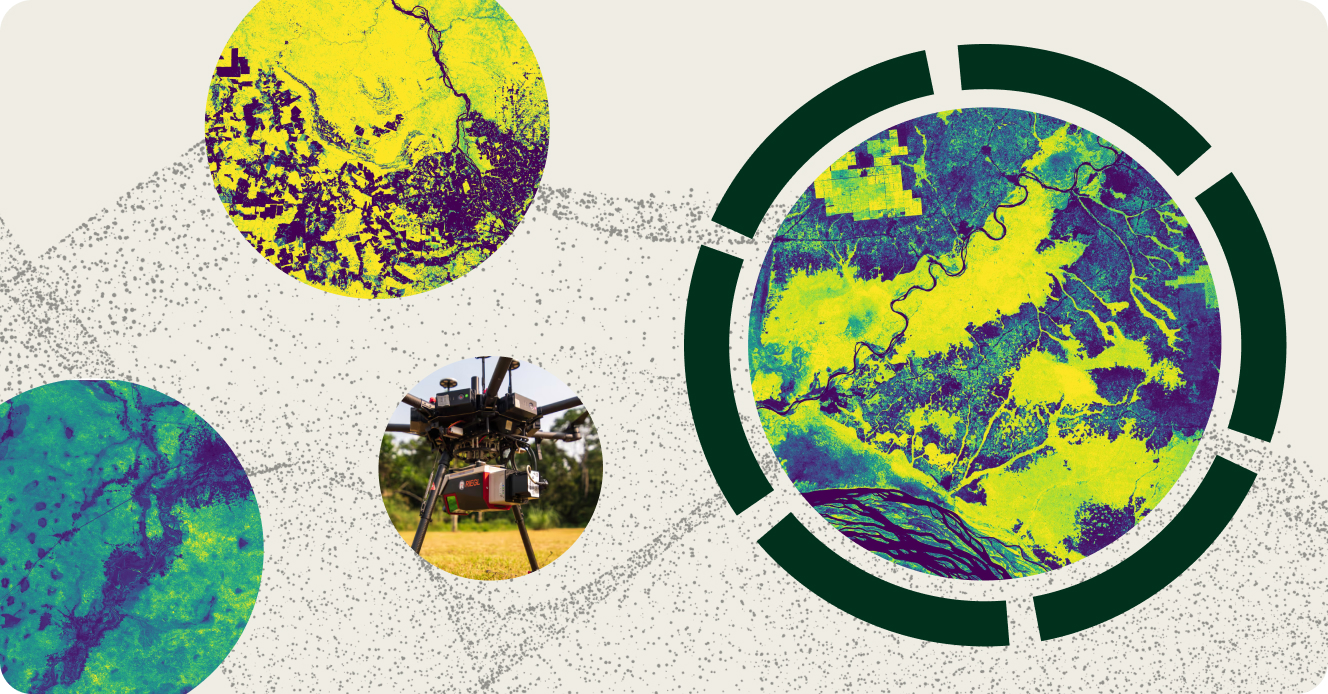“Over the years we’ve invested significantly in our field data team - focusing on producing trusted ratings. While this ensures the accuracy of our Ratings, it doesn’t allow the scale across the thousands of projects that buyers are considering.”
For more information on carbon credit procurement trends, read our "Key Takeaways for 2025" article. We share five, data-backed tips to improve your procurement strategy.

One more thing: Connect to Supply customers also get access to the rest of Sylvera's tools. That means you can easily see project ratings and evaluate an individual project's strengths, procure quality carbon credits, and even monitor project activity (particularly if you’ve invested at the pre-issuance stage.)
Book a free demo of Sylvera to see our platform's procurement and reporting features in action.
Forests are essential to life on earth, but we're cutting them down at an alarming rate, accelerating climate change and threatening the livelihoods of a billion people who depend on these ecosystems.
Enter REDD+, a promising mechanism that pays countries and communities to keep forests standing.
There's just one problem: traditional project-based approaches have stumbled, facing criticism for inflated baselines and questionable results. Fortunately, a new strategy called jurisdictional REDD+ promises to address these shortcomings by thinking bigger.
This shift could unlock the massive funding needed to protect our remaining tropical forests, but it comes with its own set of challenges and opportunities.
In this article, we explain what REDD+ is, the difference between project-based REDD+ and jurisdictional REDD+, and how these approaches can be combined into a single, practical solution.
REDD+ 101
REDD+ refers to activities that reduce greenhouse gas emissions from deforestation and forest degradation, alongside wider activities including sustainable management of forests, and the conservation and enhancement of forest carbon stocks.
It is now widely accepted that there is no route to limiting global temperature increases to 1.5°C, or even 2°C, without halting emissions from forest loss. Apart from aggravating the climate crisis, forest loss poses serious threats to biodiversity and affects the livelihoods of an estimated 1.6 billion people who depend on forest resources. Taking action to protect forests is an urgent priority, but requires significant sums of money, hundreds of billions of dollars more than we currently spend each year.
Carbon markets have long been recognized as a great potential source of this finance, which is where REDD+ credits come in. As of April 2022, over 398 million REDD+ credits have been issued on voluntary carbon markets (VCMs), representing a quarter of all voluntary credits ever issued.
Governments and multilateral organizations have also taken an interest in REDD+. The term first came to prominence in UNFCCC talks in 2007, and the Paris Agreement brings closer links between individual REDD+ projects and their host countries' REDD+ strategies.
But REDD+ has never quite achieved its full potential as a large-scale funding mechanism to pay tropical forest countries and local communities for avoided forest emissions. In part, this is due to the challenges that traditional, project-based approaches to REDD+ have faced and the reputational damage this has caused.
Project-based REDD+
To date, REDD+ credits on the VCMs have been issued by individual projects. This is when REDD+ activities are focused on a defined area of forest (sometimes small, sometimes hundreds of thousands of hectares). A baseline level of deforestation is established for that area, informed by historic trends and activity in one or more nearby, similar reference areas. The number of credits issued by the project depends on how much deforestation has reduced relative to this baseline. For a more in depth exploration of project-based REDD+, check out our REDD+ White Paper.
Individual projects have been a successful approach to get REDD+ credits to market. Furthermore, many of the criticisms that have plagued REDD+ around MRV (monitoring, reporting, and verification) are being successfully addressed through the effective deployment of emerging technologies, including high resolution, multi-model satellite imagery, machine learning, Lidar, and real-time data transmission.
Our in-depth analysis of REDD+ projects currently on the market shows that many REDD+ credits represent verifiable, additional, and long-term GHG emission reductions, with measurable co-benefits.
However, there are also a number of projects with serious threats to their integrity. Unfortunately, these examples have damaged the reputation of REDD+ credits to many market participants, and have hindered the scaling of REDD+.
The main challenges to project-based REDD+
REDD+ projects face significant challenges. Some of the more prominent ones include:
- inflated baselines (including poor selection of reference areas)
- underreporting of deforestation (including leakage)
- permanence risk due to forest loss
- risks related to land tenure and rights
Either individually, or in concert, these shortcomings with specific projects have led to accusations of greenwashing against companies using credits from these projects to offset their emissions.
It is hoped that transitioning to jurisdictional approaches could help address many of these issues.
The big advantages of jurisdictional approaches to REDD+
Jurisdictional REDD+ is not a new idea. However, until recently, jurisdictional approaches to REDD+ have not been used to issue forest carbon credits to the VCMs. Instead, it has been used as a basis for results-based finance agreements, either between countries or with multilateral organizations such as the World Bank (e.g. through their Forest Carbon Partnership Facility).
The fundamental difference to project-level REDD+ is that all the forest in a national (i.e. whole country) or subnational (e.g. state or province) jurisdiction must be considered when setting a baseline and monitoring deforestation. With the rise of remote-sensing and artificial intelligence, this can realistically be done to a high level of accuracy, which leads to a few bug advantages.
Reduced risk of inflated baselines and overcrediting
By considering deforestation across the whole jurisdiction, using methodologies that must be aligned with international reporting standards, the risk of baseline deforestation being misrepresented is lower. This helps ensure that all credits issued genuinely represent a metric ton of CO2 prevented from reaching the atmosphere.
Leakage monitoring
Leakage is when deforestation simply moves from inside the project area to another area that is not being monitored, with no overall reduction in deforestation. Monitoring deforestation across a whole jurisdiction means that displaced deforestation will still be detected and accounted for.
Economies of scale
Investing in accurate MRV is expensive and can be a barrier to developing REDD+ programs. National or subnational coordination allows more efficient use of resources, and can also improve access to upfront sources of financing.
Incentivizing changes to policy and regulation
Because the programs are state- or nation-wide, and overseen by the government, jurisdictional approaches directly incentivize using tools of politics, policy and regulation to tackle forest emissions, going above and beyond what is feasible for project-based REDD+.
Nested REDD+
Nested REDD+ projects are aligned with jurisdictional baselines and deforestation monitoring. Essentially, this is an intermediate step between the two approaches discussed, and may offer a practical solution to the criticisms of project-level REDD+ while smoothing the transition to jurisdictional approaches.
Nesting is still in its infancy and does not have a widely accepted definition or approach when implemented. How a country structures REDD+ nesting approaches is linked to its carbon ownership rights. While many countries are willing to transfer the right to generate mitigation outcomes/carbon credits to private entities, this is not always the case. Hence, countries' nesting approaches will differ widely on the degree of autonomy that the individual projects have outside of the jurisdictional approach.
Some countries might require individual projects to transition fully into a jurisdictional REDD+ program with no separate accounting or crediting system. Others might allow individual projects to keep crediting independently. Several countries are including nesting approaches in their REDD+ strategies.
The future of REDD+ in the carbon market
A move towards jurisdictional and nested REDD+ certainly seems to be the direction of travel for the market. For example, Verra's proposed updates to their avoided deforestation methodologies adopt an approach aligned with nesting. And the IC-VCM explicitly considers jurisdictional approaches in its Assessment Framework.
A big driver of this move is the international policy context. Unlike the Kyoto Protocol, the Paris Agreement expects all parties to track their national GHG emissions and commit to targets. Countries set mitigation and adaptation goals (called Nationally Determined Contributions or NDCs) and establish plans to achieve them. This is new for developing countries, which happen to host the world's tropical forests.
Under this new scenario, developing countries have become much more interested in using all mitigation outcomes they host to meet their NDCs. This includes emissions reductions from existing and future individual REDD+ carbon projects. Because of this, some host countries are designing ways to integrate them into a broader jurisdictional program.
Regardless of the type of REDD+, credits need to be high quality
Neither approach can guarantee good quality.
Although nested and jurisdictional approaches might help address some systemic risks, scrutiny is still important to ensure credits deliver on their claims.
The factors that identify quality will be diverse and complex, and buyers should continue to conduct thorough due diligence on each and every credit they purchase.
What Sylvera is doing to help
At Sylvera, we've developed comprehensive tools to help navigate this complex transition towards jurisdictional REDD+ and identify the risks and opportunities arising from this evolution.
Ratings for individual projects
Our carbon credit Ratings help buyers conduct thorough due diligence on REDD+ investments. We've already rated 85% of existing individual REDD+ credits in voluntary carbon markets, including nested projects, and we're developing frameworks specifically for jurisdictional REDD+ projects. Our Ratings evaluate how well individual projects implement their chosen methodology, revealing where project-specific implementation might create future challenges with jurisdictional programs.
Jurisdictional Intel
Our Jurisdictional Intel provides essential market intelligence for understanding the JREDD+ landscape:
Country Assessment: Risk and readiness scores for 33 actively engaged jurisdictions, evaluation of policy frameworks and implementation capacity, and identification of overlaps between REDD+ activities at different scales.
Methodology Comparison: Side-by-side analysis of ART TREES, VCS JNR, and other methodologies, assessment of baseline setting approaches and their compatibility, and identification of methodological strengths and limitations across different standards.
Programs Tracker: Analysis of supply pipeline and market dynamics, real-time monitoring of upcoming JREDD+ program issuances, and tracking of buyer interest and sales activity across jurisdictions.
Biomass data
Sylvera's biomass data addresses this foundational problem by providing standardized, high-accuracy forest carbon data that can serve both individual projects and jurisdictional programs. Using technology that's 6x more accurate than traditional methods, our approach delivers annual biomass estimates across the world's most important forest regions - ensuring more accurate integrity assessments of forestry projects.
Methodology Profiles
Our Methodology Profiles provide essential guidance for navigating the fragmented landscape of REDD+ approaches. By conducting detailed analyses of project methodologies, such as Verra's VM0048, we evaluate the specific risks tied to each approach's baseline setting, monitoring, and data requirements.
This enables buyers and investors identify approaches that minimize risks as markets transition toward jurisdictional programs.
Want to learn more about how Sylvera can help you navigate the future of REDD+? Book a demo to talk to a qualified expert
Want to learn more about Sylvera's Ratings? Book a demo to talk to a qualified expert.
Clarification on the use of ‘REDD+': REDD+ is defined by the UNFCCC strictly to relate to activities in the forest sector that reduce emissions from deforestation and forest degradation, as well as the sustainable management of forests and the conservation and enhancement of forest carbon stocks in developing countries. Over time the term has been co-opted for use in the VCMs to cover avoided planned and unplanned deforestation projects, with the scope of activities in these projects not exactly aligned with the UNFCCC definition. Now, the definition of REDD+ is being stretched even further by some jurisdictional standards. For example, ART TREES (Architecture for REDD+ Transactions - The REDD+ Environmental Excellence Standard) methodologies also recognize activities in HFLD (high forest, low deforestation) jurisdictions and emissions removals through forest restoration and replanting. Here, we use REDD+ in broad terms to cover all these activities, for clarity throughout.






.jpg)

.avif)









